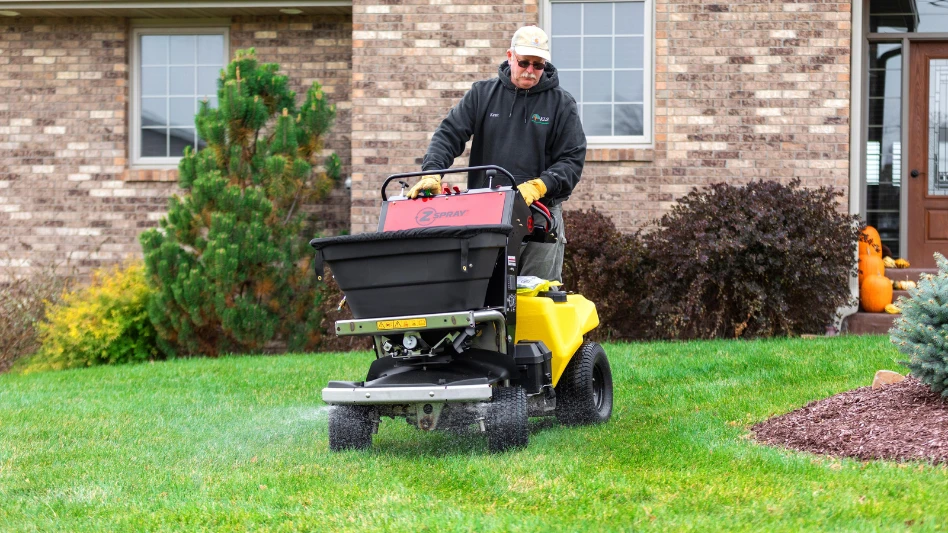With many customers consider cutting back services, tree care can help companies boost their bottom lines. Here, Bartlett Tree Experts explains how they profit by positioning fertilization and soil management as vital to the long-term health of trees, and something that can be improved with scientific, tangible soil tests.
A different animal
Landscape trees and shrubs have unique soil needs – very different from turf and other plantings. When evaluating these plants, it is important to remember there is almost nothing “natural” about urban and suburban soil. The best soil conditions for plant health are found in a forest environment where fallen leaves, twigs and branches decompose, thus supplying nutrients and a protective blanket of mulch. This litter keeps the soil free from compaction and provides large pores for air exchange and water drainage. In developed landscapes, plants often lack the necessary nutrients and conditions for optimal growth. Topsoil is often removed and subsoil spread on the soil surface, destroying the natural soil structure.
Studies conducted by scientists at The Bartlett Tree Research Laboratories and several universities have found that when fallen leaves are removed, between 2 and 5 pounds of nitrogen are lost per 1,000 square feet of soil. And, walkways, driveways, pedestrian foot traffic and other man-made elements compact soil, decreasing the intake of water and air.
An essential service
Healthy soil is about more than just fertilization. Adjusting the soil pH to an ideal level for the species will ensure nutrients are available to plants. Soil organic matter improves soil nutrient and moisture retention, provides resistance to compaction and serves as a source of nutrients as well as a food source for soil microbial populations.
With this in mind, soil management services should not be viewed as an “add- on” to core services such as pruning or pest and disease management. These services are essential to the health of trees and shrubs and, as such, can be a key part of a tree company’s business. They also require additional training, as well as an understanding of state licensing and regulation requirements in relation to fertilization.
Because fertilization is a key to the long-term health of trees, this service best matches a customer base that favors a proactive approach to tree care and places a high value on the appearance of their properties.
The first step
Every soil is different – sometimes even on a single property. A one-size-fits-all approach will not be as effective as a customized treatment program. Local field observations combined with soil testing yields the best results.
At Bartlett Tree Experts, before any fertilization is prescribed, soil samples are taken from the property and soil nutrient status is analyzed. From more than 10,000 soil samples from client properties each year, Bartlett has developed regional blends of fertilizers designed for specific geographic areas.
According to Kevin Kenney, a top seller of soil management services at Bartlett Tree Experts, the ability to provide clients specific recommendations based on testing is a strong sales tool. Clients can better see how soil management works as part of an integrated approach to their tree care and more readily understand the value.
Bartlett has the best success selling this service face-to-face when they can fully explain its benefits. Also, many times Bartlett offers soil analysis free of charge, with analysis results providing the data needed to convince clients the service is valuable. Typical marketing channels used to reinforce the value of this service include direct mail and a dedicated section and resources on the company Web site.
In today’s economy, where customers may consider cutting back services, fertilization and soil management should be positioned as vital to the long-term health of trees. For customers who want lush foliage, vigorous growth and a beautiful property, this service cannot be neglected. Trees growing in unfavorable soil conditions are more susceptible to root issues, disease, infestation and adverse weather, which can lead to serious problems or even tree failure.
Preparation is key
A full understanding of the real cost of production, training, overhead and other related costs is critical to structuring pricing. Planning is also key to profitability.
Jack Bedosky, senior vice president at Bartlett Tree Experts, says maintaining a good backlog is important, so multiple properties can be serviced in the same trip. Appropriate mapping and scheduling of work is essential as it helps dilute labor and material costs and increase profits.
To further promote productivity, these services can often be scheduled on inclement days when weather may prevent other tree care work.
As a specialized service, soil management also has the ability to bring a premium price. “Not every tree care company provides soil management services,” Bedosky says. “This work requires special equipment, knowledge and skills. Pricing should be set to reflect the company’s investment in these assets.”
The author is marketing manager at Bartlett Tree Experts, Stamford, Conn. For more information, visit www.bartlett.com.
Get curated news on YOUR industry.
Enter your email to receive our newsletters.
Explore the June 2009 Issue
Check out more from this issue and find your next story to read.
Latest from Lawn & Landscape
- PERC helps debut propane direct-injection fuel system at ACT Expo 2025
- Retargeting Ads – A Secret Weapon for Growing Your Lawn Care Business
- Leading a growing company
- Project EverGreen launches Clean Air Calculator
- Rain Bird acquires smart lawn care company OtO from Toronto
- PBI-Gordon names Marvin as VP of research and development
- Mean Green rolls out Vanquish Autonomous mower
- Focal Pointe launches new podcast series






